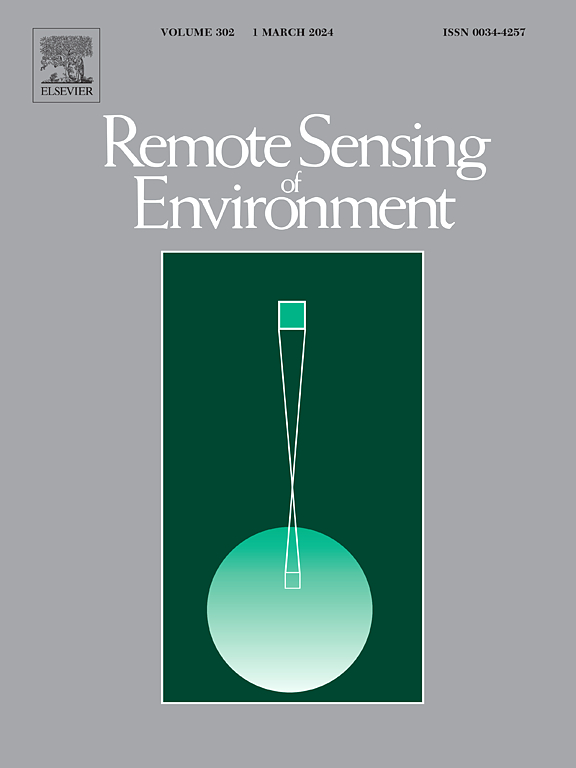利用多源数据,基于机器学习生成中国上空高分辨率三维全覆盖气溶胶分布数据
IF 11.1
1区 地球科学
Q1 ENVIRONMENTAL SCIENCES
引用次数: 0
摘要
气溶胶污染严重影响太阳辐射与地球大气的相互作用,严重威胁人类健康。许多研究已经应用机器学习模型,如极端梯度增强(XGBoost)和光梯度增强机(LightGBM)来估计气溶胶相关参数,包括气溶胶光学深度和颗粒物浓度(如PM2.5)。然而,目前的气溶胶产品主要提供水平或空间不连续的垂直数据,缺乏全面的三维(3D)覆盖。为了解决这一差距,我们开发了XGBoost-LightGBM-小波(XLW)模型,集成了XGBoost、LightGBM和小波变换来合并多源数据。该方法首次为2015年中国提供了高分辨率、三维、全覆盖的气溶胶分布数据。模式输出水平分辨率为0.05°的气溶胶空间分布数据集,垂直方向10 km范围内有167层。XLW模式显示出良好的预测能力,有效地填补了气溶胶分布的空白。与云气溶胶激光雷达和红外探路者卫星观测(CALIPSO)数据相比,它增强了信号的连续性并加强了低层信号,与地面激光雷达观测结果紧密匹配,提供了更准确的表征。该数据集准确地揭示了气溶胶的三维分布,对全面研究不同地区不同高度气溶胶的分布具有重要意义。在地面以上300 m高度,污染最严重的地区是华北平原和长江三角洲地区,平均气溶胶消光系数(AEC)分别为0.34和0.40 km−1。随着海拔高度增加至1 km,华北平原和长三角地区的平均AEC显著降低,分别为0.23和0.24 km−1。到3公里时,气溶胶分布在中国大部分地区变得稀疏。对于典型城市、华北平原和长江三角洲气溶胶分布的垂直变化,气溶胶浓度在近地表至4 km处呈下降趋势。而在珠江三角洲,气溶胶浓度在0 ~ 2 km范围内持续下降,在2 ~ 3 km范围内相对稳定。在4公里以上,所有典型城市的气溶胶浓度几乎可以忽略不计。XLW模式可以准确生成高分辨率、三维、全覆盖的气溶胶空间分布数据集,这对于深入研究气溶胶输送、气溶胶辐射效应和气候变化至关重要。本文章由计算机程序翻译,如有差异,请以英文原文为准。
Machine learning-based generation of high-resolution 3D full-coverage aerosol distribution data over China using multisource data
Aerosol pollution significantly influences the interaction between solar radiation and the earth's atmosphere and seriously threatens human health. Numerous studies have applied machine learning models such as Extreme Gradient Boosting (XGBoost) and Light Gradient Boosting Machine (LightGBM) to estimate aerosol-related parameters, including aerosol optical depth and particulate matter concentrations (e.g., PM2.5). However, current aerosol products primarily provide horizontal or spatially discontinuous vertical data, lacking comprehensive three-dimensional (3D) coverage. To address this gap, we developed the XGBoost-LightGBM-Wavelet (XLW) model, integrating XGBoost, LightGBM, and wavelet transforms to merge multisource data. This approach, for the first time, produced high-resolution, three-dimensional, full-coverage aerosol distribution data for China in 2015. The model outputs a dataset of aerosol spatial distribution with a horizontal resolution of 0.05°, and 167 layers within 10 km in the vertical direction. The XLW model demonstrates excellent predictive ability, effectively filling gaps in aerosol distribution. It enhances signal continuity and strengthens lower-layer signals, closely matching ground LiDAR observations and providing a more accurate representation compared to the Cloud-Aerosol LiDAR and Infrared Pathfinder Satellite Observation (CALIPSO) data. The dataset accurately reveals the 3D distribution of aerosols, which is meaningful for a comprehensive study of aerosol distribution at different altitudes in various regions. At 300 m height above ground level, the most polluted regions are the North China Plain and the Yangtze River Delta region, with an average aerosol extinction coefficient (AEC) of 0.34 and 0.40 km−1, respectively. As the height increases to 1 km, the average AEC notably decreases to 0.23 and 0.24 km−1 in the North China Plain and the Yangtze River Delta. By 3 km, aerosol distribution becomes sparse over most regions of China. For the vertical variations of aerosol distributions in typical cities, in the North China Plain and Yangtze River Delta, aerosol concentrations consistently decrease from the near-surface to 4 km. However, in the Pearl River Delta, aerosol concentrations decrease consistently from 0 to 2 km, with relatively stable between 2 and 3 km. Above 4 km, aerosol concentrations are nearly negligible in all typical cities. The XLW model can accurately produce a high-resolution, 3D, full-coverage aerosol spatial distribution dataset, which is vital for conducting thorough studies on aerosol transport, aerosol radiative effects, and climate change.
求助全文
通过发布文献求助,成功后即可免费获取论文全文。
去求助
来源期刊

Remote Sensing of Environment
环境科学-成像科学与照相技术
CiteScore
25.10
自引率
8.90%
发文量
455
审稿时长
53 days
期刊介绍:
Remote Sensing of Environment (RSE) serves the Earth observation community by disseminating results on the theory, science, applications, and technology that contribute to advancing the field of remote sensing. With a thoroughly interdisciplinary approach, RSE encompasses terrestrial, oceanic, and atmospheric sensing.
The journal emphasizes biophysical and quantitative approaches to remote sensing at local to global scales, covering a diverse range of applications and techniques.
RSE serves as a vital platform for the exchange of knowledge and advancements in the dynamic field of remote sensing.
 求助内容:
求助内容: 应助结果提醒方式:
应助结果提醒方式:


